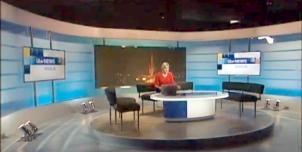Full Freeview on the Sudbury (Suffolk, England) transmitter
| Google Streetview | Google map | Bing map | Google Earth | 52.005,0.786 or 52°0'17"N 0°47'8"E | CO10 5NG |
The symbol shows the location of the Sudbury (Suffolk, England) transmitter which serves 440,000 homes. The bright green areas shown where the signal from this transmitter is strong, dark green areas are poorer signals. Those parts shown in yellow may have interference on the same frequency from other masts.
_______
Digital television services are broadcast on a multiplexes (or Mux) where many stations occupy a single broadcast frequency, as shown below.
64QAM 8K 3/4 27.1Mb/s DVB-T MPEG2
H/V: aerial position (horizontal or vertical)
The Sudbury (Suffolk, England) mast is a public service broadcasting (PSB) transmitter, it does not provide these commercial (COM) channels: .
If you want to watch these channels, your aerial must point to one of the 80 Full service Freeview transmitters. For more information see the will there ever be more services on the Freeview Light transmitters? page.
Which Freeview channels does the Sudbury transmitter broadcast?
If you have any kind of Freeview fault, follow this Freeview reset procedure first.Digital television services are broadcast on a multiplexes (or Mux) where many stations occupy a single broadcast frequency, as shown below.
64QAM 8K 3/4 27.1Mb/s DVB-T MPEG2
H/V: aerial position (horizontal or vertical)
The Sudbury (Suffolk, England) mast is a public service broadcasting (PSB) transmitter, it does not provide these commercial (COM) channels: .
If you want to watch these channels, your aerial must point to one of the 80 Full service Freeview transmitters. For more information see the will there ever be more services on the Freeview Light transmitters? page.
Which BBC and ITV regional news can I watch from the Sudbury transmitter?

BBC Look East (East) 0.8m homes 3.2%
from Norwich NR2 1BH, 77km north-northeast (24°)
to BBC East region - 27 masts.
70% of BBC East (East) and BBC East (West) is shared output

ITV Anglia News 0.8m homes 3.2%
from NORWICH NR1 3JG, 78km north-northeast (24°)
to ITV Anglia (East) region - 26 masts.
All of lunch, weekend and 80% evening news is shared with Anglia (West)
Are there any self-help relays?
| Felixstowe West | Transposer | 1000 homes +1000 or more homes due to expansion of affected area? | |
| Witham | Transposer | 14 km NE Chelmsford. | 118 homes |
How will the Sudbury (Suffolk, England) transmission frequencies change over time?
| 1984-97 | 1997-98 | 1998-2011 | 2011-13 | 1 Aug 2018 | |||||
| B E T | B E T | B E T | E T | K T | |||||
| C29 | SDN | ||||||||
| C31 | ArqA | ||||||||
| C35 | C5waves | C5waves | |||||||
| C37 | ArqB | ||||||||
| C41 | ITVwaves | ITVwaves | ITVwaves | D3+4 | D3+4 | ||||
| C44 | BBC2waves | BBC2waves | BBC2waves | BBCA | BBCA | ||||
| C47 | C4waves | C4waves | C4waves | BBCB | BBCB | ||||
| C51tv_off | BBC1waves | BBC1waves | BBC1waves | ||||||
| C56tv_off | ArqB | ||||||||
| C58tv_off | SDN | ||||||||
| C60tv_off | -ArqA |
tv_off Being removed from Freeview (for 5G use) after November 2020 / June 2022 - more
Table shows multiplexes names see this article;
green background for transmission frequencies
Notes: + and - denote 166kHz offset; aerial group are shown as A B C/D E K W T
waves denotes analogue; digital switchover was 6 Jul 11 and 20 Jul 11.
How do the old analogue and currrent digital signal levels compare?
| Analogue 1-4 | 250kW | |
| SDN, ARQA, ARQB, BBCA, D3+4, BBCB | (-4dB) 100kW | |
| Analogue 5 | (-7dB) 50kW | |
| Mux 2* | (-14.9dB) 8.1kW | |
| Mux B* | (-15.2dB) 7.5kW | |
| Mux 1* | (-15.5dB) 7kW | |
| Mux A* | (-17dB) 5kW | |
| Mux C* | (-22.2dB) 1.5kW | |
| Mux D* | (-23.6dB) 1.1kW |
Which companies have run the Channel 3 services in the Sudbury transmitter area
|
|
Thursday, 26 April 2012
J
John Chambers4:46 PM
Witham
Why has there no official information about channels I had prior to November 2011 not coming back until 27 June?
I only found out by speaking to a gentlemen from Freeview and had it confirmed via this website.
| link to this comment |
John's: mapJ's Freeview map terrainJ's terrain plot wavesJ's frequency data J's Freeview Detailed Coverage
Nick: As far as the question of Sudbury or Tacolneston goes, assuming no local obstructions, the former would appear to be the much better bet.
I refer you back to my earlier posting to you on this:
Freeview on Tacolneston TV transmitter | ukfree.tv - independent free digital TV advice
Click the "Terrain between..." links for plots.
| link to this comment |
John Chambers: Indeed.
The only thing I can suggest to you in the mean time is that, if your receiver allows manual tuning, you do so to UHF channel 28. This is the equivalent service from Crystal Palace and has been available since 18th April when it switched. You may be lucky and be able to pick this up to some degree until Sudbury's power goes up.
| link to this comment |
J
jb389:35 PM
Nick / Dave Lindsay: Regarding the illustrations of the gain curves for the various aerials seen on ATV's site and the comments / recommendations made about their use, it should be appreciated that these are made in general terms irrespective of whether the aerial is used for analogue or digital reception, and my comment is not at variance with what's been said on the site (one of the few I have always approved of) but is simply a qualification concerning the possible snags that may crop up if using a particular type of aerial for digital reception under certain difficult conditions, namely non line-of-site and where the problem is not one caused by excessive distances.
Reception issues do not generally occur in very near to open line-of-site situations even at considerable distances, and so a high gain multi-element aerial can be of benefit there as it can be effectively focused to where the mast is located, however in circumstances such as completely non line-of-site then any signals received obviously has to have a reflective element attached to them or they could not be received in the first place, but because of being received that way they nearly always have an erratic and in many cases rapidly fluctuating element attached to them as is witnessed by the quality frequently being observed to dive up and down, and although this type of problem is mostly caused by trees it can also be caused by numerous other intermittently occurring reasons like the signal path being near to, or even crossing a main highway frequented by high sided vehicles.
Unlike the stability of analogue reception, the critical characteristics of digital reception cannot cope with this sort of thing resulting in the quality taking a dive, and so if an aerial with a narrow acceptance angle is used under these sort of conditions then any fluctuations on the signals being received will have much more of an effect that it would do in a lower gain wider acceptance angle aerial, and with this resulting in a much higher level of picture glitching being noticed.
The other problem with the use of a tight acceptance angle aerial in these type circumstances being that its alignment doesnt always hold for long, and so its case of peaking it for quality every month or so dependant on weather related issues.
Regret delay in replying, but I was held up by an unexpected snag at at a job today.
| link to this comment |
jb38: Thanks for the interesting insight.
The topic is coming clearer to me.
I can see how trees and passing traffic may be an issue where they pass over the brow of the hill. The brow being perminantly flat means no change in the path of the signal. Moving trees or traffic effectively acts to vary the "brow" of the hill so that it is not flat and crucially is always varying.
What about polarisation of signals? Are vertical ones affected more than horizontal ones or vice versa?
| link to this comment |
N
Nick10:58 PM
Dave and JB, you are being very helpful, thanks.
Another one. A booster is less use the further from the aerial it is placed as it amplifies a lesser signal the further along the coax it is until putting it behind the set appears to do nothing.
Why then do they put them half way or more down the pole, rather than, for instance, behind the reflector?
| link to this comment |
Nick: This page, also from Megalithia (the website that does the prediction for how good your line of sight is):
Mo' Betta - abuse of DTT TV booster amplifiers
Boosters should be fitted before loss:
- before a length of cable whose loss is too great for the signal to stand (this may be useful where there is a good quality but low amplitude signal), or;
- before a signal is split (so as to counteract the loss of splitting the signal).
| link to this comment |
J
jb3811:18 PM
Dave Lindsay: I have always found that vertically polarised signals are generally better all round, although I do have to admit that most of my non domestic involvement has always been with FM and AM equipments and as such the effect I referred to would not be applicable to these modes, as it only really applies to the reception of digital TV signals as anything of a digital commercial nature doesn't operate on the same hit and miss basis as domestic TV.
That said though, now that Rowridge transmits in both polarities I would love a chance to carry out some tests at various points around the area, but by it being a bit distant to me will just need to be content and wait to see what kind of complaints are being made from the area and with the type aerials being used by the complainants.
| link to this comment |
N
Nick11:28 PM
Nick: Dave, thanks re booster. Surely this reinforces the idea that it be placed 6 inches from the dipole rather than more than six feet?
Incidentally, I am trying a crafty move as I don't want to take the aerial down if the signal should be too strong. I have a behind the set box which does nothing there but seems to have three transistors which to me indicates it is high gain. I have housed the amplification part in a plastic box, intending to put it near the dipole, dispensed with the transformer, replaced it with one which offers 6, 7and a half, 9 0r 12 volts, and connected the two via a length of phone cable, and reduce the voltage if gain is too high. I have tried this with analogue Dover, where I am well out of range.
| link to this comment |
N
Nick11:45 PM
Norm, I am looking at the info at the top of the page that says various commercial channels from Sudbury carry programming/local news as from Meridian rather than Anglia..
| link to this comment |
Select more comments
Your comment please




